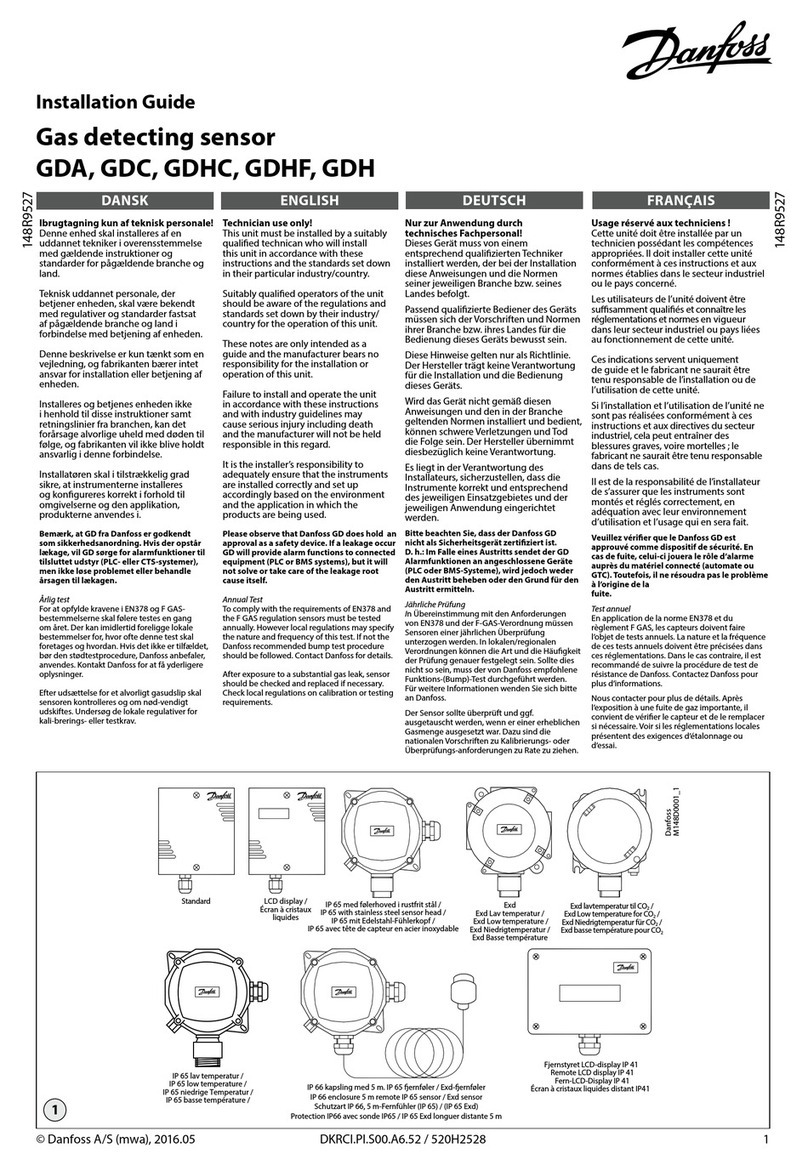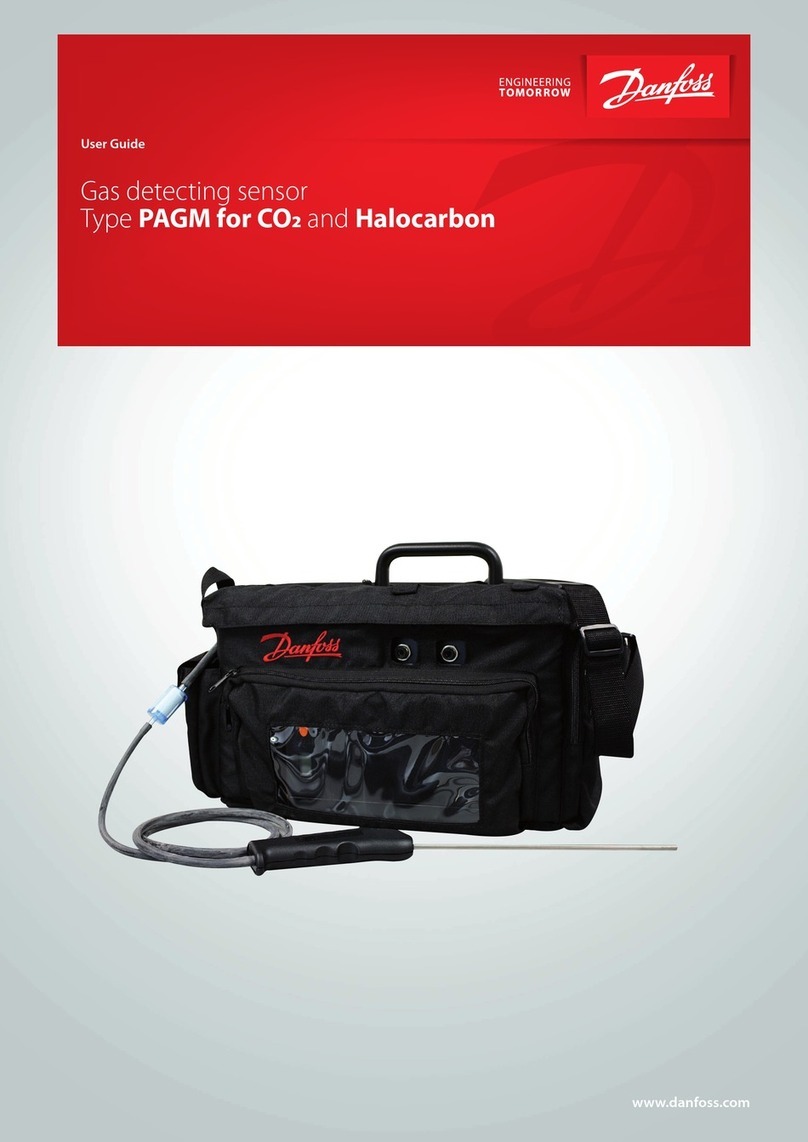
8 RI7HA352 © Danfoss A/S (RC-CMS / MWA), 02-2005
Fluides frigorigènes
Le détecteur GD peut être utilisé avec les
fluides frigorigènes suivants :
Ammoniac
· Type GDA
· 0 à 100 ppm
· 0 à 1 000 ppm
· 0 à 10 000 ppm
· 0 à 30 000 ppm
Dioxyde de carbone
· Type GDC
· 0 à 10 000 ppm
Halocarbures
HCFC
· Type GDHC
· 0 à 1 000 ppm
HFC
· Type GDHF
· 0 à 1 000 ppm
Hydrocarbures
Propane
· Type GDH
· 0 à 5 000 ppm
Plage de température
Standard, Écran à cristaux liquides, IP 65 et
EExd (figure 1) :
20 °C / + 50 °C (– 4 °F / 122 °F)
Modèle basse température :
40°C/+50°C (–40°F/122°F)
Protection
Standard IP 30 (NEMA 1)
Écran à cristaux
liquides IP 30 (NEMA 1)
IP 65 IP 65 (NEMA 4)
EExd IP 65 (NEMA 4)
Basse temp. IP 40 (NEMA 2)
Raccord de câble
1 bague pour câble 6 à 13 mm (0,2” à 0,5”)
1 trou Ø 20 mm (0,8”) avec bouchon
obturateur.
1 bague supplémentaire peut être montée.
Caractéristiques électriques
Raccordements acceptés par tous les
terminaux : 0,5 à 1,5 mm2
(20 - 15 AWG)
Tension d’alimentation
12-24 V c.a.
12-30 V c.d.
Sortie analogique
4-20 mA
0-10 V
0-5 V
Communication RS 485 avec unité de
surveillance Danfoss m2 :
Sortie numérique - contacts secs
Charge : 1 A, 24 V c.a./c.d.
Niveau d’alarme basse
NO (par défaut)
NF
Niveau d’alarme haute
NO (par défaut)
NF
Installation
Procédure générale pour tous les types
de produits GD (figures 2 et 3)
Tous les produits GD sont conçus pour un
montage mural.
• Enlever le couvercle supérieur du
détecteur GD.
• Pour les types Standard, Écran à cristaux
liquides et Basse température (figure 2) :
• Dévisser les deux vis frontales
(quatre sur le type Basse
température)
• Pour les types IP 65 et EExd (figure 3) :
• Dévisser les quatre vis frontales
Installation électrique (figures 4 et 5)
Effectuer la mise à la terre en cas
d’utilisation des types Standard, Écran
à cristaux liquides ou Protection EExd.
La sûreté de l’équipement dépend de la
stabilité de l’alimentation électrique et de
la mise à la terre de la protection.
Mettre sous tension la CON 1 et la DEL
verte s’allume (figure 5).
La normalisation complète du détecteur
lors de sa mise sous tension peut
demander un certain temps (quelques
minutes à plusieurs heures).
Vous pouvez la contrôler en vérifiant la
progression vers zéro de la sortie 0-10 V sur
la CON 3.
Durant la période de normalisation, la DEL3
jaune ou la DEL2 rouge peuvent s’allumer
et indiquer des alarmes de niveau bas ou
de niveau haut.
En cas de changement d’un cavalier, il
est nécessaire de couper l’alimentation
(CON1) afin d’activer le réglage du
nouveau cavalier.
Réglage de Normalement Ouvert (NO)
/ Normalement Fermé (NF) de la sortie
numérique alarme de niveau bas ou de
niveau haut.
Elles peuvent être réglées toutes deux sur
NO ou NF. Réglage en usine : NO.
Sortie numérique Alarme de niveau bas
NO : JP3 ON (marche), JP4 OFF (arrêt)(retiré)
NF : JP4 ON (marche), JP3 OFF (arrêt) (retiré)
(Figure 5)
Sortie numérique Alarme de niveau haut
NO : JP5 ON (marche) en position supérieure
NF : JP5 ON (marche) en position inférieure
(Figure 5)
Réinitialisation manuelle / réinitialisa-
tion automatique de Alarme de niveau
bas ou de niveau haut (figure 5)
Option disponible à l’aide de JP8 (Bas) et
JP7 (Haut)
Réglage en usine : réinitialisation
automatique
Si la réinitialisation manuelle est
sélectionnée pour l’alarme de niveau bas
ou de niveau haut, elle est activée via le
bouton-poussoir situé à côté de la CON 7.
Sortie numérique Alarme de niveau bas
Réinitialisation automatique : JP8 en
position à gauche
Manuelle : JP8 en position à droite
Sortie numérique Alarme de niveau haut
Réinitialisation automatique : JP7 en
position à gauche
Manuelle : JP7 en position à droite
Réglage temps de réponse avec délai
(figure 5)
La sortie numérique Alarme de niveau bas
ou de niveau haut peut comporter un délai.
Réglage en usine : 0 minute
(300 secondes pour les GDHC et GDHF)
Sortie numérique Alarme de niveau bas
JP1 en position
1 : 0 minute
2 : 1 minute
3 : 5 minutes
4 : 10 minutes
Sortie numérique Alarme de niveau haut
JP2 en position
1 : 0 minute
2 : 1 minute
3 : 5 minutes
4 : 10 minutes
Réglage des valeurs d’alarme basse-
haute (figure 6)
Tous les détecteurs GD sont préréglés en
usine sur des valeurs réalistes et conformes
à la plage ppm réelle du produit GD. Le
détail des valeurs ppm limites des alarmes
basse et haute actuelles est donné sur
le marquage GD externe. Les valeurs
préréglées en usine peuvent être modifiées
à l’aide d’un voltmètre mesurant la sortie
0-5 V c.d.
0 V correspond à la plage ppm minimale
(par exemple 0 ppm)
5 V correspond à la plage ppm maximale
(par exemple 1000 ppm)
Par exemple, si un réglage de 350 ppm est
requis, la tension doit être réglée sur 1,75 V
(35 % de 5 V)
Réglage de la valeur limite d’alarme basse
Entre TP0(-) et TP2(+), il est possible de
mesurer une tension entre 0 et 5 V qui
correspond au réglage de la valeur limite
ppm de l’alarme basse.
La tension (le ppm) peut être réglée sur
RV1.
Réglage de la valeur limite d’alarme haute
Entre TP0(-) et TP3(+), il est possible de
mesurer une tension entre 0 et 5 V qui
correspond au réglage de la valeur limite
ppm de l’alarme haute. La tension (le ppm)
peut être réglée sur RV2.
Connexion du détecteur GD à une unité
Danfoss m2 (figures 7 et 8)
Câblage (figure 7)
Tous les détecteurs GD doivent être raccordés
A-A
B-B
COM – COM (écran)
Lors du raccordement au panneau de m2,
les bornes identiques sont connectées
entre elles, c’est-à-dire A-A, B-B, Com – Com.
Sur le dernier ensemble détecteur GD +
Danfoss m2, monter une résistance de 120
ohms entre les bornes A et B pour achever
le système de communication.
Il est possible de raccorder jusqu’à 31
détecteurs de gaz.
En cas de besoins dépassant les 31 unités,
veuillez prendre contact avec Danfoss pour
obtenir des informations complémentaires.
Adresse GD (figure 8)
L’adresse du détecteur est réglée à l’aide
de S2 et S3 ; le réglage de ces boutons
gradués sur une valeur comprise entre 0 et
F donnera au détecteur sa propre adresse,
comme indiqué dans la figure 8. Un tableau
de conversion entre les numéros de canaux
m2 et l’adresse hexadécimale du ST-IAM 2
est joint. Couper l’alimentation pour régler
les adresses sur le détecteur GD.
FRANÇAIS




























